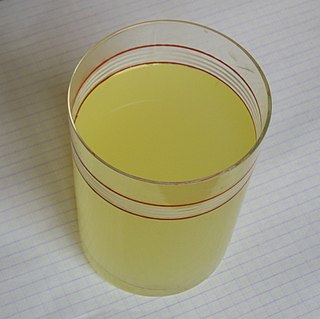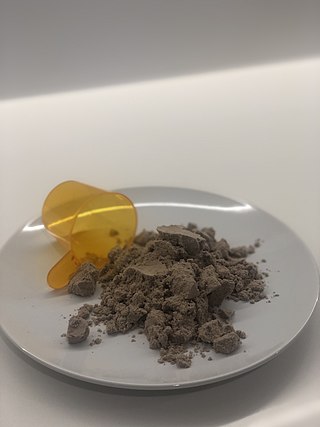Soy whey is the clear liquid obtained after curdling the proteins in soy milk to form tofu (tofu whey), or after curdling out the proteins in a soy extract to make soy protein isolate (SPI whey). It is named in analogy to the clear liquid by-product from cheese production, whey. It is traditionally treated as wastewater, though some work has been done to try and produce more valuable products out of it. [1]
Tofu whey may contain components of the soy milk as well as the coagulant used, which could be either acid-based or mineral-based. It contains 0.85% carbohydrates (largely stachyose, raffinose, and sucrose; no lactose), 0.13–0.82% protein, 0.4–1% fat, and about 0.4% minerals (as ash). [1]
Soy protein isolate is made by curdling proteins out of a weakly alkaline, aqueous extract of defatted soy using an acid. SPI whey contains 0.95% carbohydrates, 0.03–0.3% protein, no fat (because defatted soy is used to make the extract), and about 0.2% minerals (as ash). [1]
Besides these components, soy whey also contains isoflavones, which are potentially valuable. [1]
Very little has been done commercially in transforming soy whey into more valuable products. [1]
The minerals in tofu whey can be recovered for reuse as tofu coagulant. The carbohydrates in soy whey, especially the oligosacchides, are functional food ingredients. The proteins have good emulsifying properties. [1]
A number of different organisms can be used to ferment soy whey to produce a drink. Soy whey with added sugar can be fermented with yeast into a wine similar to sake. [2] Soy whey can be fermented with lactic acid bacteria to obtain a sour drink, or to obtain a sauerkraut starter. This liquid can also support the growth of fungi (including mushrooms and yeasts) and microalgae. [1]

Lactose, or milk sugar, is a disaccharide composed of galactose and glucose and has the molecular formula C12H22O11. Lactose makes up around 2–8% of milk (by mass). The name comes from lact (gen. lactis), the Latin word for milk, plus the suffix -ose used to name sugars. The compound is a white, water-soluble, non-hygroscopic solid with a mildly sweet taste. It is used in the food industry.

Rennet is a complex set of enzymes produced in the stomachs of ruminant mammals. Chymosin, its key component, is a protease enzyme that curdles the casein in milk. In addition to chymosin, rennet contains other enzymes, such as pepsin and a lipase.

The soybean, soy bean, or soya bean is a species of legume native to East Asia, widely grown for its edible bean, which has numerous uses.

Whey is the liquid remaining after milk has been curdled and strained. It is a byproduct of the manufacturing of cheese or casein and has several commercial uses. Sweet whey is a byproduct resulting from the manufacture of rennet types of hard cheese, like cheddar or Swiss cheese. Acid whey is a byproduct brought out during the making of acid types of dairy products, such as strained yogurt.

Curd is obtained by coagulating milk in a sequential process called curdling. It can be a final dairy product or the first stage in cheesemaking. The coagulation can be caused by adding rennet, a culture, or any edible acidic substance such as lemon juice or vinegar, and then allowing it to coagulate. The increased acidity causes the milk proteins (casein) to tangle into solid masses, or curds. Milk that has been left to sour will also naturally produce curds, and sour milk cheeses are produced this way.

Textured or texturized vegetable protein (TVP), also known as textured soy protein (TSP), soy meat, or soya chunks, is a defatted soy flour product, a by-product of extracting soybean oil. It is often used as a meat analogue or meat extender. It is quick to cook, with a protein content comparable to some meats.

Soy milk, also known as soya milk or soymilk, is a plant-based milk produced by soaking and grinding soybeans, boiling the mixture, and filtering out remaining particulates. It is a stable emulsion of oil, water, and protein. Its original form is an intermediate product of the manufacture of tofu. Originating in China, it became a common beverage in Europe and North America in the latter half of the 20th century, especially as production techniques were developed to give it a taste and consistency more closely resembling that of dairy milk. Soy milk may be used as a substitute for dairy milk by individuals who are vegan or lactose intolerant.

Whey protein is a mixture of proteins isolated from whey, the liquid material created as a by-product of cheese production. The proteins consist of α-lactalbumin, β-lactoglobulin, serum albumin and immunoglobulins. Glycomacropeptide also makes up the third largest component but is not a protein. Whey protein is commonly marketed as a protein supplement, and various health claims have been attributed to it. A review published in 2010 in the European Food Safety Authority Journal concluded that the provided literature did not adequately support the proposed claims.
Hydrolyzed vegetable protein (HVP) products are foodstuffs obtained by the hydrolysis of protein, and have a meaty, savory taste similar to broth (bouillon).

Fermented tofu is a Chinese condiment consisting of a form of processed, preserved tofu used in East Asian cuisine. The ingredients typically are soybeans, salt, rice wine and sesame oil or vinegar. In mainland China the product is often freshly distributed. In overseas Chinese communities living in Southeast Asia, commercially packaged versions are often sold in jars containing blocks 2- to 4-cm square by 1 to 2 cm thick soaked in brine with select flavorings.

Okara, soy pulp, or tofu dregs is a pulp consisting of insoluble parts of the soybean that remain after pureed soybeans are filtered in the production of soy milk and tofu. It is generally white or yellowish in color. It is part of the traditional cuisines of Japan, Korea, and China. Since the 20th century, it has been used in the vegetarian cuisines of Western nations.

In food processing, fermentation is the conversion of carbohydrates to alcohol or organic acids using microorganisms—yeasts or bacteria—without an oxidizing agent being used in the reaction. Fermentation usually implies that the action of microorganisms is desired. The science of fermentation is known as zymology or zymurgy.
Biological value (BV) is a measure of the proportion of absorbed protein from a food which becomes incorporated into the proteins of the organism's body. It captures how readily the digested protein can be used in protein synthesis in the cells of the organism. Proteins are the major source of nitrogen in food. BV assumes protein is the only source of nitrogen and measures the amount of nitrogen ingested in relation to the amount which is subsequently excreted. The remainder must have been incorporated into the proteins of the organisms body. A ratio of nitrogen incorporated into the body over nitrogen absorbed gives a measure of protein "usability" – the BV.
Soy molasses is brown viscous syrup with a typical bittersweet flavor. A by-product of aqueous alcohol soy protein concentrate production, soy molasses is a concentrated, desolventized, aqueous alcohol extract of defatted soybean flakes.

Soy protein is a protein that is isolated from soybean. It is made from soybean meal that has been dehulled and defatted. Dehulled and defatted soybeans are processed into three kinds of high protein commercial products: soy flour, concentrates, and isolates. Soy protein isolate has been used since 1959 in foods for its functional properties.

Tofu is a food prepared by coagulating soy milk and then pressing the resulting curds into solid white blocks of varying softness: silken, soft, firm, and extra firm. Tofu is translated as bean curd in English. Tofu originated in China and has been consumed in the country for over 2,000 years. Tofu is a traditional component of many East Asian and Southeast Asian cuisines; in modern Western cooking, it is often used as a meat substitute.

Pea protein is a food product and protein supplement derived and extracted from yellow and green split peas, Pisum sativum. It can be used as a dietary supplement to increase an individual's protein or other nutrient intake, or as a substitute for other food products. As a powder, it is used as an ingredient in food manufacturing, such as a thickener, foaming agent, or an emulsifier.

Hemp juice is a beverage derived from industrial hemp, made from the result of pressing the Cannabis sativa plant. The juice is obtained through a large-scale industrial cold-pressing procedure using the upper parts of the hemp plant as well as the leaves. This procedure distinguishes hemp juice from other hemp products such as hemp oil, hemp sprouts or hemp milk, which are obtained through the seeds of the hemp plant.

Corn sauce or fermented corn sauce is produced by fermentation using corn starch as the primary substrate. It is used as a food condiment and ingredient, both in paste and in powder form. Corn sauce, like soy sauce, has a characteristic savory taste. It is used to flavor dishes including soups, broths, and gravies.